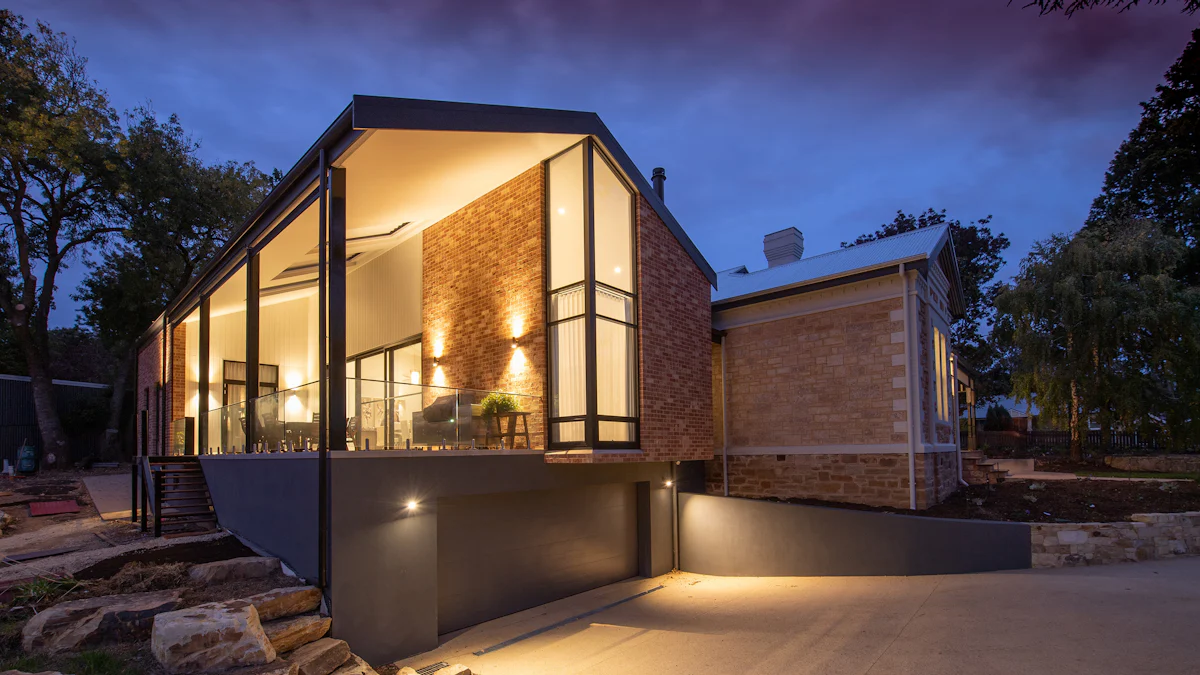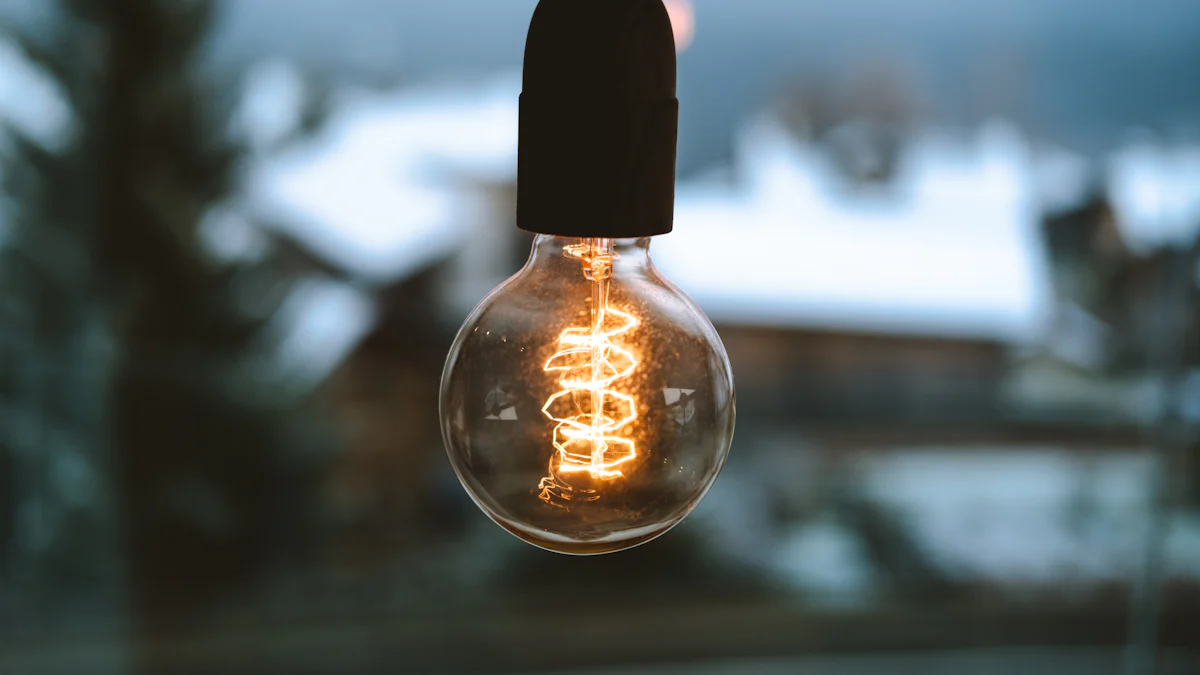Exterior Flood Light with Outlet: A Comprehensive Buying Guide

When it comes to outdoor lighting solutions, selecting the right exterior flood light with outlet is crucial for optimal illumination and functionality. Considering factors like lumens, wattage, color temperature, IP rating, and additional features can significantly impact the effectiveness of your outdoor lighting setup. With the LED flood light market experiencing a steady growth rate and LED lights dominating the market share due to their efficiency and longevity, choosing wisely becomes even more essential. Let's delve into the key considerations that will guide you in making an informed decision for your outdoor space.
Understanding Lumens and Wattage

LED flood lights are at the forefront of outdoor lighting solutions, offering unparalleled efficiency and performance. When considering lumens versus wattage, it is essential to understand the distinction between these two metrics to make an informed decision for your outdoor space.
Definition and Importance of Lumens
Lumens measure the total amount of visible light emitted by a light source, indicating its brightness level. Unlike wattage, which measures power consumption, lumens directly quantify the light output. Opting for LED flood lights with higher lumens ensures a brighter illumination while consuming less energy, making them a cost-effective and eco-friendly choice.
In recent studies on LED flood lights efficiency and performance, it has been consistently found that these lights produce 100–150 lumens per watt, showcasing their superior brightness capabilities compared to traditional lighting options. By focusing on lumens rather than wattage, users can achieve optimal brightness levels without compromising energy efficiency.
Understanding Wattage in LED Flood Lights
The wattage of LED flood lights plays a crucial role in determining their energy consumption and overall brightness. From low-wattage options suitable for residential settings to industrial-grade fixtures designed for large-scale applications, the range of available wattages caters to diverse lighting needs.
Research highlights that LED flood lights with higher wattages deliver enhanced brightness levels, making them ideal for illuminating expansive outdoor areas effectively. By selecting the appropriate wattage based on your specific requirements, you can ensure that your outdoor space is adequately lit while minimizing energy costs.
Choosing the Right Brightness
When selecting an exterior flood light with an outlet, assessing the optimal brightness level is paramount to achieving desired lighting outcomes. Several factors contribute to determining the right brightness for your space:
Purpose: Consider whether the area requires bright illumination for security reasons or ambient lighting for aesthetic appeal.
Size: Larger spaces may necessitate higher lumen outputs to ensure uniform coverage and visibility.
Environment: Outdoor conditions such as ambient light levels and potential obstructions should influence your brightness selection.
Task-specific Needs: Tailor the brightness level based on specific activities conducted in the illuminated area.
To provide practical guidance on choosing the right brightness level, experts recommend conducting a thorough assessment of your outdoor space's requirements. By aligning the lumens and wattage of your LED flood light with these considerations, you can create a well-lit environment that meets both functional and visual needs effectively.
Importance of Color Temperature
What is Color Temperature?
Definition and Measurement
Color temperature refers to the characteristic hue of light sources, measured in Kelvin (K). Understanding color temperature is essential for selecting the most suitable lighting ambiance for your outdoor space. Lower color temperatures, around 2700-3000K, emit a warm white glow ideal for creating a cozy atmosphere. In contrast, higher color temperatures, such as 5000-6500K, produce a cool white light that enhances visibility and security in outdoor areas.
Impact on Outdoor Lighting
The color temperature of outdoor lighting significantly influences the perception and functionality of illuminated spaces. Opting for warmer hues can promote relaxation and socialization in patios or gardens, while cooler tones are preferred for pathways and security lighting. Studies have shown that LED lights can replicate natural sunlight effectively, improving visibility and enhancing overall safety outdoors.
Selecting the Right Color Temperature
Security and Visibility Considerations
Choosing the appropriate color temperature is crucial for ensuring optimal security and visibility in outdoor environments. Warmer tones may create a welcoming ambiance but could compromise visibility in certain areas. For enhanced safety measures, selecting cooler color temperatures with higher Kelvin ratings can improve clarity and help deter potential intruders by illuminating dark corners effectively.
Aesthetic and Functional Aspects
In addition to security concerns, considering the aesthetic and functional aspects of color temperature is paramount when designing your outdoor lighting scheme. Harmonizing the color temperature with the architectural features of your property can elevate its visual appeal while providing practical illumination. By strategically placing lights with varying color temperatures, you can create depth and dimension in your outdoor landscape design.
With an array of options available on the market, from warm white to daylight bulbs, homeowners have the flexibility to customize their outdoor lighting based on personal preferences and practical needs. Whether aiming to highlight specific landscaping elements or enhance overall safety around the property perimeter, selecting the right color temperature plays a pivotal role in achieving desired lighting effects outdoors.
By understanding how different color temperatures influence mood, perception, and functionality in outdoor settings, individuals can make informed decisions when choosing exterior flood lights with outlets that best suit their unique requirements. Remember that each hue has its distinct impact on the ambiance created within your outdoor space; therefore, thoughtful consideration of color temperature is key to achieving a well-balanced and visually appealing lighting setup.
IP Rating for Durability
Understanding IP Ratings
Explanation of IP Rating System
To ensure the longevity and performance of your outdoor flood lights, understanding the Ingress Protection (IP) rating system is crucial. The IP rating consists of two numbers: the first digit indicates protection against solid objects like dust, while the second digit signifies resistance to water and moisture. A higher IP rating translates to better protection against environmental factors, making it essential for outdoor applications.
Minimum IP Rating for Outdoor Flood Lights
When selecting flood lights for outdoor use, it is recommended to choose fixtures with a minimum IP rating of 65. This rating ensures that the light is completely dust-tight and protected against low-pressure jets of water from all directions. By opting for flood lights with this level of protection, you can rest assured that your outdoor lighting solution is durable and capable of withstanding various weather conditions.
Ensuring Waterproof and Durability
Importance of High IP Rating
The importance of a high IP rating cannot be overstated when it comes to outdoor flood lights. A robust housing with a high IP rating guarantees that the fixture is not only resistant to dust but also fully waterproof. This level of durability ensures that your flood lights remain operational even in challenging environments, such as heavy rain or snow.
Examples of Durable Flood Lights
When exploring options for durable outdoor flood lights, LED flood lights stand out as top contenders due to their exceptional build quality and weather-resistant design. These lights are specifically engineered to withstand harsh outdoor conditions, including rain, snow, and extreme temperatures. With an emphasis on durability without compromising on performance, LED flood lights offer a reliable lighting solution for various outdoor settings.
Look for LED flood lights that are explicitly designed for outdoor use and feature a high IP rating to guarantee long-term functionality in any weather condition. By investing in quality fixtures with superior durability features, you can illuminate your outdoor spaces effectively while minimizing maintenance needs and ensuring consistent performance over time.
Consideration of the IP rating plays a pivotal role in determining the reliability and longevity of your chosen exterior flood light with an outlet. By prioritizing fixtures with adequate protection against environmental elements, you can enjoy well-lit and resilient outdoor areas year-round without concerns about premature wear or damage due to external factors.
Additional Features
When considering an exterior flood light with outlet, it's essential to explore the additional features that can enhance both safety and convenience in your outdoor lighting setup. Two key elements to focus on are built-in GCFI outlets and beam angle adjustments, which play a crucial role in optimizing the functionality and performance of your LED flood lights.
Built-in GCFI Outlets
One standout feature of modern LED flood lights is the integration of built-in GCFI outlets, providing users with added safety benefits and streamlined installation processes. These outlets are designed to protect against electrical shocks by quickly shutting off power in case of a ground fault, ensuring a secure lighting environment for both residential and commercial applications.
To further enhance safety measures, consider LED flood lights equipped with built-in GCFI outlets that meet industry standards for electrical protection. By incorporating this feature into your outdoor lighting system, you can minimize potential hazards and create a secure outdoor space for various activities.
In addition to safety considerations, the presence of built-in GCFI outlets offers unparalleled convenience during outdoor installations. With easy access to power sources directly from the light fixture, users can effortlessly connect additional devices or tools without the need for separate electrical outlets. This seamless integration simplifies wiring processes and eliminates the hassle of managing multiple power sources, making it ideal for DIY enthusiasts and professional installers alike.
Beam Angle and Light Distribution
Another critical aspect to evaluate when selecting an exterior flood light with outlet is the beam angle and light distribution capabilities. LED flood lights are known for their versatility in adjusting beam angles to suit different lighting requirements, offering customizable solutions for various outdoor settings.
The beam angle of a flood light determines the spread and coverage of light emitted, influencing the overall brightness and visibility in illuminated areas. For expansive spaces that require broad illumination, opt for flood lights with wider beam angles to ensure uniform lighting across large surfaces. Conversely, narrower beam angles provide more focused and concentrated lighting ideal for highlighting specific features or architectural elements within your outdoor landscape.
When choosing the right beam angle for different areas, consider factors such as size, purpose, and desired lighting effects to achieve optimal results. By aligning the beam angle with your specific requirements, you can effectively illuminate pathways, gardens, or façades while enhancing visual appeal and security outdoors.
Many LED flood lights offer adjustable features like tilt, rotation, and customizable beam angles to cater to diverse lighting needs. Whether you're illuminating backyard spaces or accentuating landscaping elements, selecting flood lights with versatile beam angle options allows you to tailor the light distribution according to your preferences.
In summary, prioritizing exterior flood lights with outlets that excel in lumens, wattage, color temperature, IP rating, and additional features is essential for optimal outdoor lighting solutions. For the best choice, consider products like the Wyze Cam Floodlight with 2600 Lumen LEDs, which offers powerful illumination and smart security features. With easy installation and robust performance, this floodlight enhances both lighting and safety. Make informed decisions based on your specific needs to create a well-lit and secure outdoor environment.
See Also
A Comprehensive Guide to Purchasing Bendable LED Work Lights
Installing Outdoor Ceiling Lights: Waterproofing Techniques & Advice
Selecting Cordless LED Work Lights from China: A Complete Manual
Top 4 Outdoor Waterproof LED Lights: Tried and Reviewed
Selecting the Perfect Compact Waterproof LED Lights for Your Requirements
